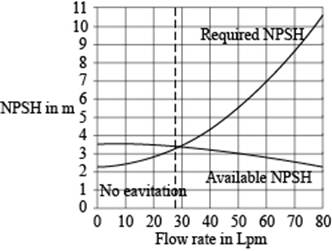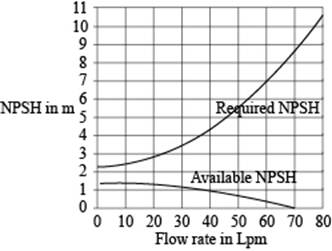
Repeat Prob. 14-60. but at a water temperature of 80°C. Repeat for 90°C. Discuss.
The maximum volume flow rate at which cavitation occur.
Answer to Problem 61P
The maximum volume flow rate at which cavitation occur is
Explanation of Solution
Given information:
The temperature of the water is
Write the expression for the required head using the energy balance equation.
Here, the initial pressure is
Write expression for the available net positive suction head at the pump inlet.
Here, the saturation pressure is
Write the expression for the minor losses.
Here, the minor loss coefficient due to sharp edge is
Write the expression for the velocity of the water.
Write the expression for the Reynolds number.
Here, the density of the water is
Write the expression for the minor losses.
Write the expression for the required net positive suction head.
Write the expression for the friction factor.
Here, the friction factor is
Calculation:
Refer to the Table-A-7E, "Properties of saturated liquid" to obtain the density of the water as
Substitute
Substitute
Use hit and trial method to obtain the volume flow rate.
Iteration 1 consider the volume flow rate as
Substitute
Substitute
Substitute
Substitute
Substitute
Since, the available net positive suction head is greater than the required net positive suction head hence, cavitation does not occur at this flow rate.
The different iteration are shown in the below Table.
| S.No | |||
| 1 | |||
| 2 | |||
| 3 | |||
| 4 | |||
| 5 | |||
| 6 | |||
| 7 | |||
Draw the plot between the flow rate and available net positive suction head and the required net positive suction head.

Figure-(1)
Figure-(1) shows that the cavitation occur at volume flow rates above the
Refer to the Table-A-7E, "Properties of saturated liquid" to obtain the density of the water as
Substitute
Substitute
Use hit and trial method to obtain the volume flow rate.
Iteration 1 consider the volume flow rate as
Substitute
Substitute
Substitute
Substitute
Substitute
Since, the available net positive suction head is greater than the required net positive suction head hence, cavitation does not occur at this flow rate.
The different iteration are shown in the below Table.
| S.No | |||
| 1 | |||
| 2 | |||
| 3 | |||
| 4 | |||
| 5 | |||
| 6 |
Draw the plot between the flow rate and available net positive suction head and the required net positive suction head.

Figure-(2)
From Figure-(2), available net positive suction head and the required net positive suction head curves are not crossing each other as the temperature of water is near to boiling temperature. The pump cavitates at any flow rate.
Conclusion:
The maximum volume flow rate at which cavitation occurs is
Want to see more full solutions like this?
Chapter 14 Solutions
Fluid Mechanics: Fundamentals and Applications
- For the draining liquid fi lm of Fig. , what are theappropriate boundary conditions ( a ) at the bottom y 5 0and ( b ) at the surface y 5 h ?arrow_forwardA fluid of water at 1 atm with a vapor pressure of 0.2 psi and a critical cavitation number of 0.3 (Cacritical=Patm-Pvap/0.5V2) How fast does cavitation occur?arrow_forwardWrite down the formula of Clausius inequality, explain all parameters in it and comment when the equality sign “=“ would applyarrow_forward
- What do differential and integral analyses of kinetic data entail? Which is more precise and why?arrow_forwardDefine the Under steady-flow conditions?arrow_forwardAnswer the question considering the information given in the picture D) Sometimes when pipeline pressure calculations are made, the pressures in certain points can be negative, what is the meaning of a negative pressure? Justify.arrow_forward
- A gasoline engine is at a location where the temperature is measured to be 14.2 °C and produces 347 KW at 5800 rpm while consuming 0.0184 kg's of fuel. During operation, data shows that its mechanical energy loss is 18 %, the actual volume of air going into each cylinder is 80% (the volumetric efficiency has a negligible variation), and the actual fuel-to-air ratio is 0.065. What were the engine parameters at sea level conditions if the pressure here is 100.3 kPa and the temeratur here is 18 Uc hotter than that of the alevated conditions? Determine at sea-level conditions the ISFC in ka/kW-hr Use four (4) decimal places in your solution and answer.arrow_forwardA gasoline engine is at a location where the temperature is measured to be 14.2 °C and produces 347 KW at 5800 rpm while consuming 0.0184 kg's of fuel. During operation, data shows that its mechanical energy loss is 18 %, the actual volume of air going into each cylinder is 80% (the volumetric efficiency has a negligible variation), and the actual fuel-to-air ratio is 0.065. What were the engine parameters at sea level conditions if the pressure here is 100.3 kPa and the temeratur here is 18 Uc hotter than that of the alevated conditions? Determine at sea-level conditions the ISFC in ka/kW-hrarrow_forwardWhat are the Key Features of Torricelli’s Law ? Explain it's Applicability?arrow_forward
- 8. A coal fired steam boiler uses 3000 kg of coal per hour. Air required for combustion is 15.5 kg ofcoal at barometric pressure of 98.2 KPa. The flue gas has temperature of 285 degree Celsiusand an average molecular weight of 30. Assuming an ash loss of 11% and allowable gas velocityof 7.5 meters per second. Find the diameter of the chimney 9. The gas density is 0.75 kg per cubic meters and air density is of 1.15 kg per cubic meter. If thedriving pressure is 0.25 KPA. Determine the height of the chimney. 10. A powerplant situated at an altitude having an ambient air of 96.53 KPa and 23.88 degreeCelsius. Flue gases at a rate of 5.0 kg per second enter the stack at 200 degree Celsius andleaves at 160 degree Celsius. The flue gases gravimetric analysis are 18% CO2, 7% O2 and 75%N2. Calculate the height of the stack necessary for a driving pressure of 0.20 KPaKindly answer all please. Thank youarrow_forwardWhat is the critical value of the pressure coefficient for an airplane flying at 170m/s in air at 2 deg C?arrow_forwardExplain about Bernoulli's equation with any one practical example.arrow_forward
 Refrigeration and Air Conditioning Technology (Mi...Mechanical EngineeringISBN:9781305578296Author:John Tomczyk, Eugene Silberstein, Bill Whitman, Bill JohnsonPublisher:Cengage Learning
Refrigeration and Air Conditioning Technology (Mi...Mechanical EngineeringISBN:9781305578296Author:John Tomczyk, Eugene Silberstein, Bill Whitman, Bill JohnsonPublisher:Cengage Learning
